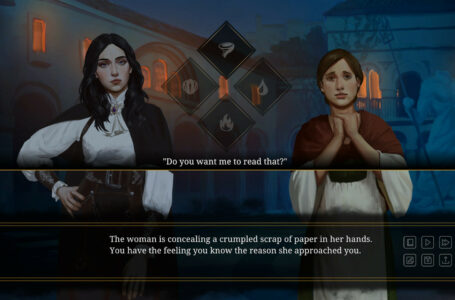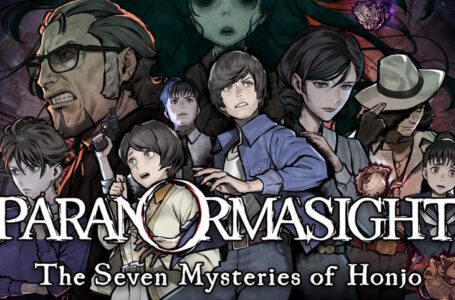The many tonal shifts of Full Metal Daemon Muramasa
One of the things that is consistently strong about Nitroplus’ work in general is the fact that it is rarely beholden to a single style or tone. This is apparent in many of their works, be it the aspects of horror found in Saya no Uta, the intertwining plotlines and enormously varied conclusions to Steins;Gate, the changes of narrative perspective in Deus Machina Demonbane — or indeed, the myriad surprising and often horrifying sudden tonal shifts in Full Metal Daemon Muramasa
The game’s third chapter is an excellent example of this, both in terms of how, as a chapter to the overall story, it has a very different feel to what has come before — and also with regard to a number of scenes which occur over the course of its duration. Since I write this as I am still progressing through my first playthrough of the game, I can only assume that things end up a little differently if you make different choices along the way — but suffice to say that while I expected things to end somewhat along the lines in which they did, I wasn’t quite prepared for the exact details of said conclusion.
Naturally, in order to discuss this matter in depth, there will be spoilers ahead — specifically for Chapter Three of Full Metal Daemon Muramasa. Please bear this in mind before reading further!
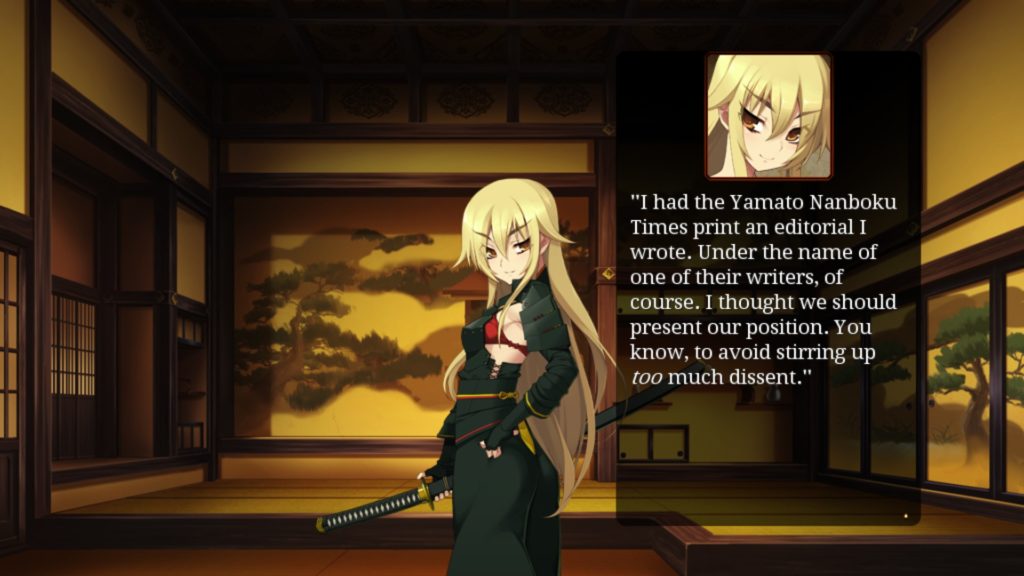
The third chapter of Full Metal Daemon Muramasa, known as The Avenger, begins with a behind-the-scenes look at the Rokuhara Shogunate, a group that has been little more than an ill-defined but nonetheless indisputably evil bogeyman up until this point. We are introduced to several major figures from the group, two of whom take on a certain amount of prominence in Chapter Three, and the others of whom will presumably become more relevant in subsequent hours.
This is just preamble, though; the main point of Chapter Three — at least, it seems that way, anyhow — is to explore a subject which was previously teased back in the game’s first chapter. Before everything went fairly thoroughly south for everyone involved, the characters Yuhi and Tadayasu introduced the concept of “crux racing”, which is a sport in the world of Full Metal Daemon Muramasa. This involves specially modified tsurugi — variants on the mass-produced kazu’uchi rather than the legendary shin’uchi — competing in a parallel to real-world motorsport.
It’s testament to the quality of the writing and worldbuilding in Full Metal Daemon Muramasa that the sport has been thought out properly. Up until this point, we’ve seen that even mass-produced tsurugi are capable of flight, so how could racing possibly work? By implementing strict regulations, of course: racing cruxes are obliged to pass beneath all the arches on a racetrack, and have to go back and pass the previous arch again if they miss one. These rules actually have their roots in real-life motorsports; in most disciplines, a competitor obviously cutting a corner is obliged to hang back and retake a previous position in order to counter the advantage they were attempting to give themselves.
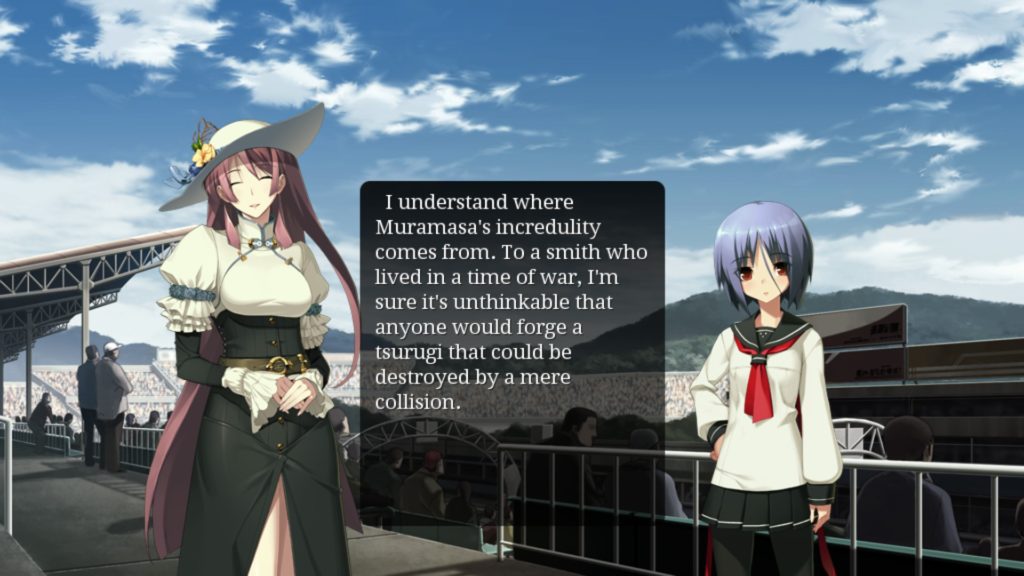
As always, though, there’s something a bit more sinister at work here. So far, we’ve established that Full Metal Daemon Muramasa’s protagonist Minato Kageaki and his tsurugi Muramasa are pursuing the “eggs” of Ginseigo, another legendary tsurugi that, we learn as part of some exposition in Chapter Three, is piloted by what remains of Minato’s sister. I say “what remains” because it’s strongly implied that she lost her mind a long time ago even before allowing Ginseigo to dominate her utterly — though the exact circumstances of this remain somewhat shrouded in mystery. We know just one thing: Minato feels absolute crippling guilt over these circumstances, and this is one of many reasons why he persistently punishes himself.
The reason we hit the racetrack in Chapter Three is because Minato and Muramasa track one of Ginseigo’s “eggs” to the local crux racing course, which is about to host a national Grand Prix. The pair find themselves struggling quite a bit, however, because despite some thorough investigation, Muramasa is unable to pin down the exact location of Ginseigo’s egg. And without a precise location, they of course cannot destroy it.
What then follows is the team of Minato, Muramasa, Otori Kanae and Ayane Ichijo — all characters that we’ve had a chance to get to know quite well over the course of the first two chapters — working together to figure out the situation, and eventually get Minato and Muramasa into the race itself in order to investigate even more thoroughly.
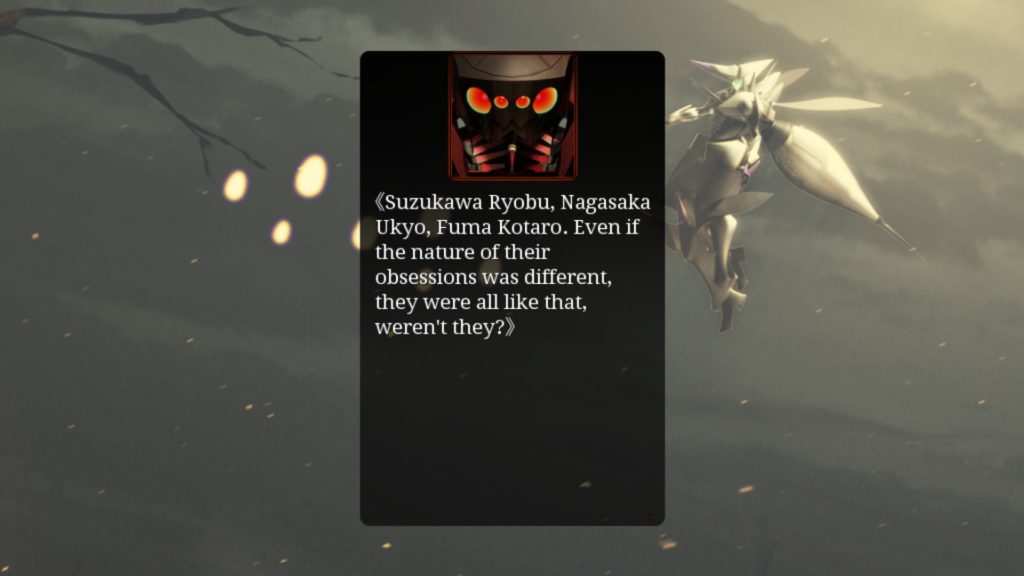
Initially, the majority of the chapter feels like an anime themed around racing teams; Minato and Otori are obviously enthusiastic about the subject matter and Ayane is curious, and as part of their investigations they come into contact with Oji Suguru, a legendary racer from days of yore, and his daughter Misao.
The latter has, it seems, been becoming something of an “idol” on the racing circuit since her debut, while her father’s career was cut short by the war that led to Rokuhara’s occupation of Yamato. So it’s fair to say that there’s plenty of passion there, and a feeling of impending “triumph”. You’re rooting for Oji Suguru and his daughter; their passion for victory makes you feel like they “deserve” to win.
But most readers will probably reach a conclusion about where the chapter is going long before the main cast will, particularly as Muramasa herself repeatedly emphasises that Ginseigo’s “eggs” are inevitably implanted in the tsurugi of people who desire power. And it’s obvious that Oji Suguru in particular very much desires power — specifically, the power to recapture his glory days, whatever the cost might be, by vicariously living through Misao.
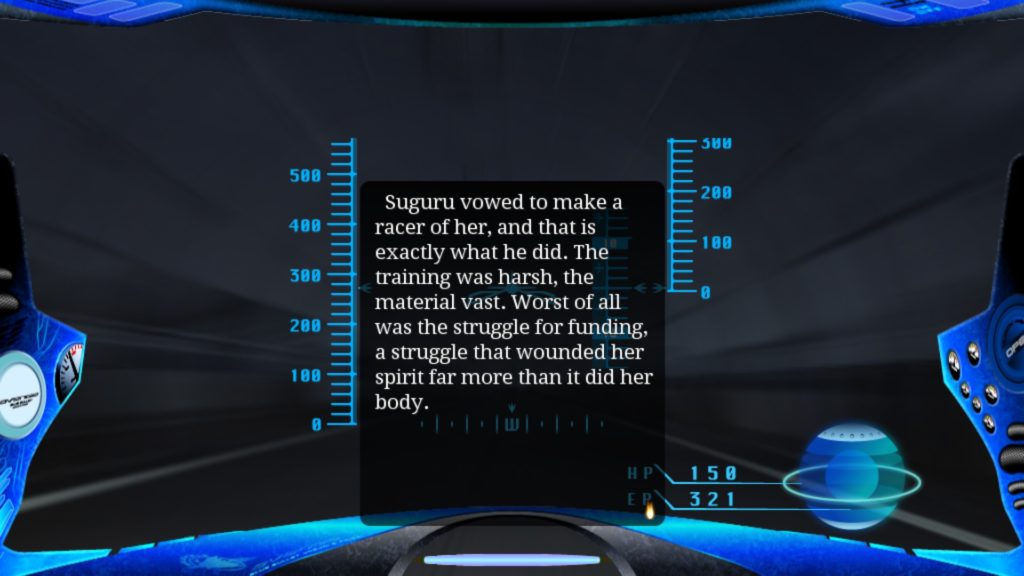
In fact, we’re given an explicit idea of exactly how far Suguru is willing to go in the name of pursuing his dream in a pretty unpleasant sex scene where a dead-eyed Misao is being gangbanged by three fat executives as Suguru apparently watches. At the time, the exact meaning and context of this scene isn’t made completely clear, but we can draw a few conclusions; as always, it’s about money. After all, what’s a little violation of a family member if you can get the money you need to realise your lifelong dreams?
Amid all this back-and-forth between the feel of an enthusiastic, triumphant sports anime and the darkness of an underground crime thriller, we also have Otori and Ayane’s scenes together, usually while Minato is off doing something else. Towards the opening of Chapter Three, the pair were very much established as “rivals” for Minato’s affection; despite initially feeling negatively towards him, his actions throughout Chapter Two end up impressing Ayane, while Otori has been a constant presence in the background for most of the narrative up until this point.
The basic tropes that initially appear to define Ayane and Otori are “tsundere delinquent” and “spoiled princess” respectively, but the pair of them habitually break what we might initially assume to be their character, particularly when interacting with one another. Ayane quickly determines that having a pop at Otori’s towering stature is a bit of a sore point for her, for example, while Otori is a little too eager to prove her apparent love for Minato any time Ayane shows the slightest hint of demonstrating any affection towards him.
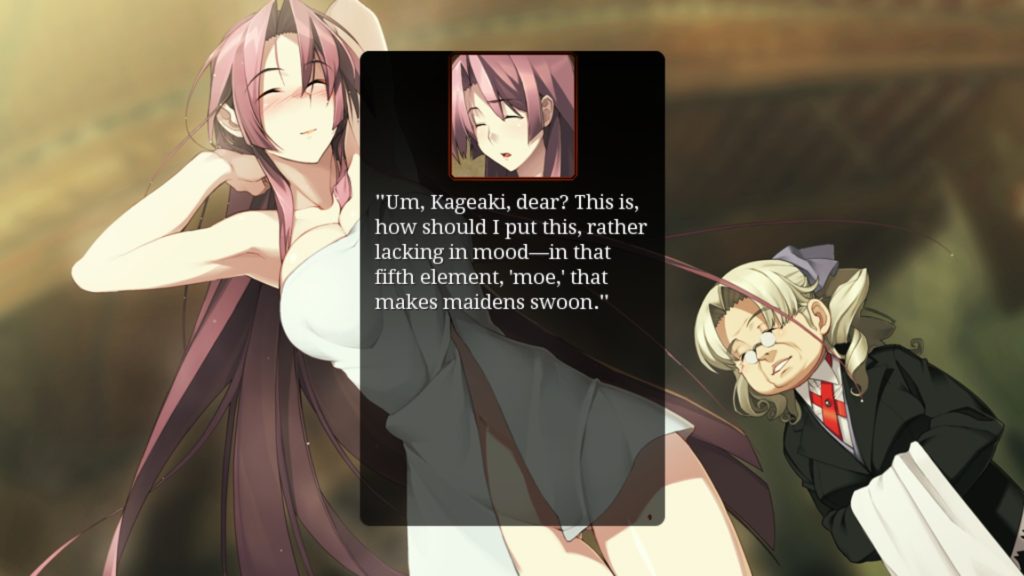
In other words, their scenes in Full Metal Daemon Muramasa are typically filled with a fair amount of comedy; Otori in particular has, up until this point in the game as a whole, been a very pleasingly humorous character, sporting some formidable “gap moe” between the way she typically acts and the occasional (all right, quite frequent) slipping of her “mask” any time she is provoked even a little bit out of her comfort zone.
A real highlight of Chapter Three is that mainstay of the eroge: a scene in which Minato wanders in on Otori getting changed. But Minato is no blushing high schooler; instead, when Otori attempts to tease him into embarrassment by asking him if he’d like to see under her towel, his response is the refreshingly frank and honest “Yes. I enjoy looking at naked women, particularly those as attractive as yourself. If you wish to show me your body, I will be happy to avail myself of the opportunity.” Otori, of course, has absolutely no response to this whatsoever; she knows when she’s beaten. Absolute brilliance.
Otori’s true intentions have, up until this point, been a bit shrouded in mystery. We know that she works for the British-led “GHQ”, an organisation that we are clearly supposed to have confused and mixed feelings about at this point in the narrative. We know that she’s a highly capable soldier, and that she’s fiercely independent; much of what happens in Chapter Two is down to the fact that she refuses to just sit back and be a corrupt official like she’s expected to be.
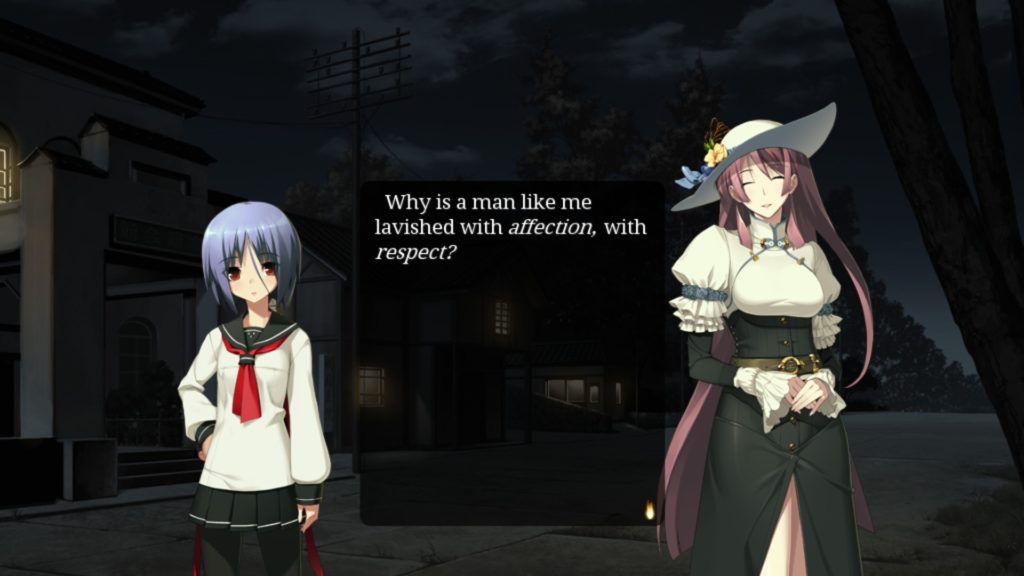
She takes an interest in Minato early on, and it’s never quite clear if she’s genuinely on his side, or just trying to figure him out. Her flirtatiousness and jealousness towards Ayane often makes it appear like she genuinely likes him — but in the third-person scenes where we’re not looking out through Minato’s eyes, it becomes very clear that she knows a lot more things than she’s letting on.
It’s fair to say that a natural assumption would be that she is going to play a major role in Full Metal Daemon Muramasa. Which is why it came as such a genuine surprise to me that Chapter Three of my particular playthrough concluded with Minato murdering her.
Minato murdering someone who didn’t deserve to die is nothing new at this point, of course — we’ve seen him do so at the conclusion of both the previous chapters — but it was a genuine surprise to see someone who had, up until this point, been positioned as a “main heroine”. She had her own entry on the affection meter, after all — and, like the sequence in Chapter Two where Minato murders two side characters, said affection meter is “cut” and splattered with blood at the time this all happens.
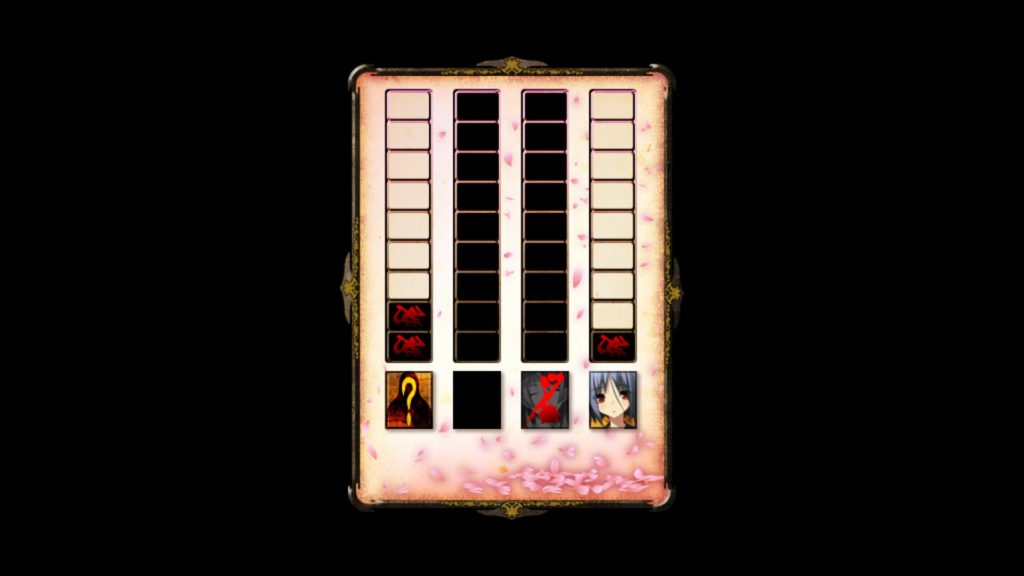
To be fair, Full Metal Daemon Muramasa — indeed, Muramasa herself — has warned us numerous times by this point that we shouldn’t develop too much affection for anyone — specifically using that word. And yet, despite this, we’ve been given no reason to assume that the game’s “affection meter” is anything other than exactly what it claims to be: a meter demonstrating Minato’s level of affection for various major characters, and thus the likelihood that you will end up on their route or seeing their ending.
But at the point Minato murders Otori, the meter isn’t full or anything; in my case, it just happened to be the highest out of all of them, and this was primarily down to the fact that Otori was present in the story earlier than Ayane and thus had much more opportunity to “earn points”, as it were.
This, of course, raises a lot of questions. Up until this point, choosing options that benefit a particular character and/or Minato’s relationship with them has increased their affection meter, which is typically assumed to be a good thing in a game like this — even one with dark themes. But with this scene, we’re presented with the distinct possibility that attempting to “pursue” a character in the traditional visual novel manner will, in fact, end up with them meeting a violent end well before they have the opportunity to get their story rolling.
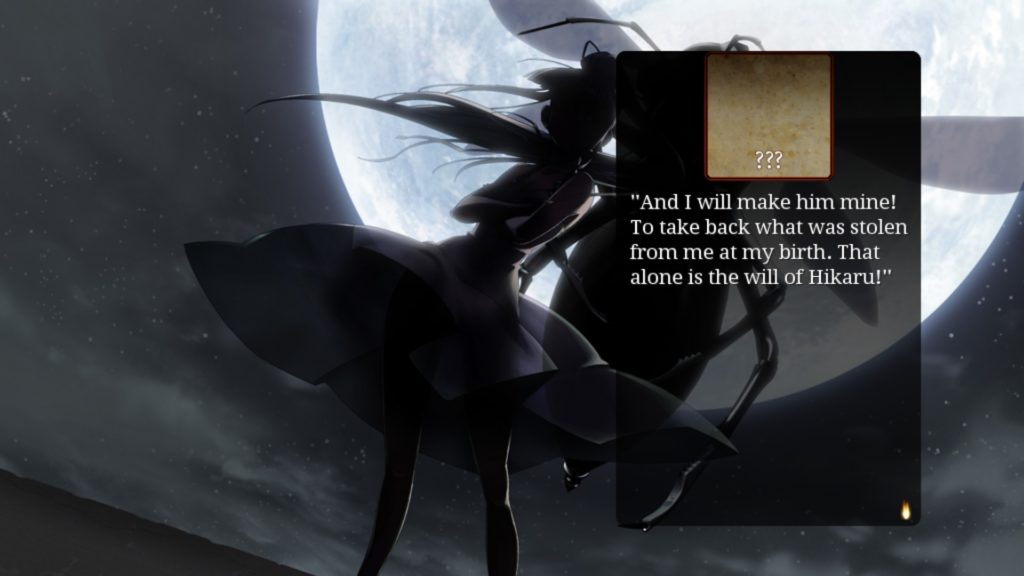
Does that mean we should deliberately ignore them? Does it mean we should try to antagonise them? Or does it mean we should attempt to “balance” our affection for everyone who comes our way? Moreover, exactly why is Minato murdering people who were only tangentially related to the actual main problem of the chapter in the first place?
These are answers that, at this point in Full Metal Daemon Muramasa, we don’t have. But it’s going to be interesting — and doubtless a little disturbing — to uncover those truths. And in the meantime, what we have is a game that is very much willing to slap you in the face and tell you to constantly expect the unexpected; this is no ordinary “dating sim”-style visual novel, so you probably shouldn’t get too attached to anyone.
And on top of that, you shouldn’t get too comfortable with any one particular tone, either; for every moment of absolute, crushing, depressing darkness, there is one of levity; and for every belly laugh there is an instance of utter tragedy. What a truly, truly fascinating work of fiction; I can’t wait to see what’s next.
Full Metal Daemon Muramasa is available now from JAST USA. A “streamer-friendly” version is available on GOG.com.
Join The Discussion
Rice Digital Discord
Rice Digital Twitter
Rice Digital Facebook
Or write us a letter for the Rice Digital Friday Letters Page by clicking here!
Disclosure: Some links in this article may be affiliate links, which means we may earn a small commission if you make a purchase after clicking on them. This is at no additional cost to you and helps support Rice Digital!
- Letter from the Editor: passing the torch - June 30, 2023
- Super Woden GP 2 is looking promising - June 30, 2023
- Inti Creates is making a 32 bit-style Love Live action platformer - June 26, 2023






